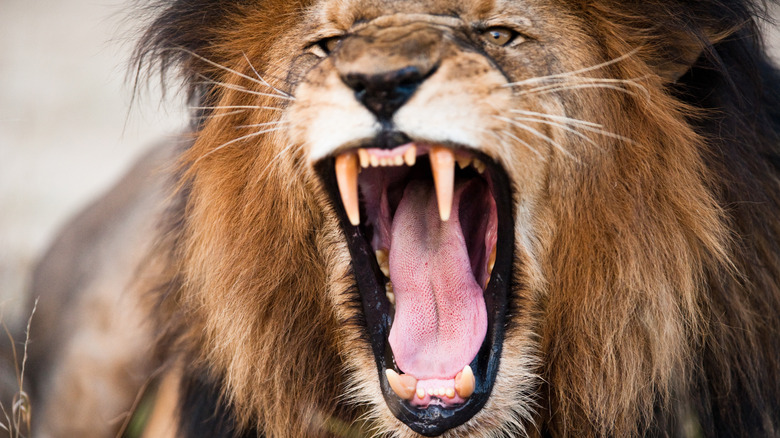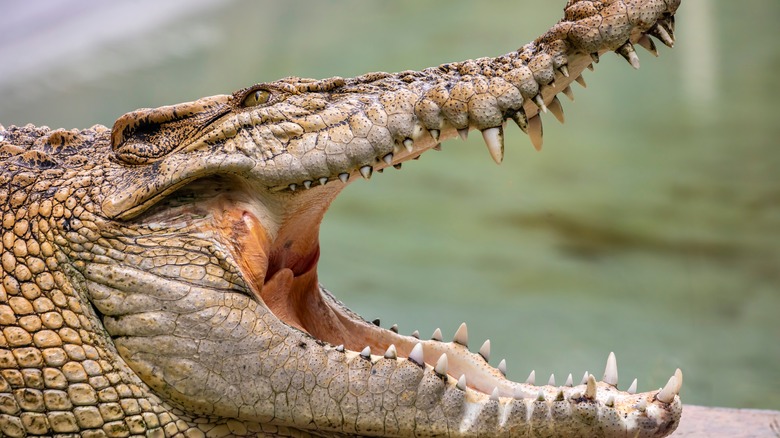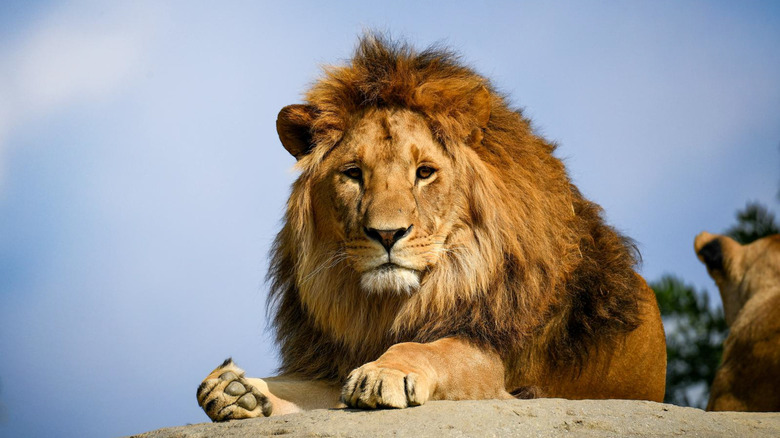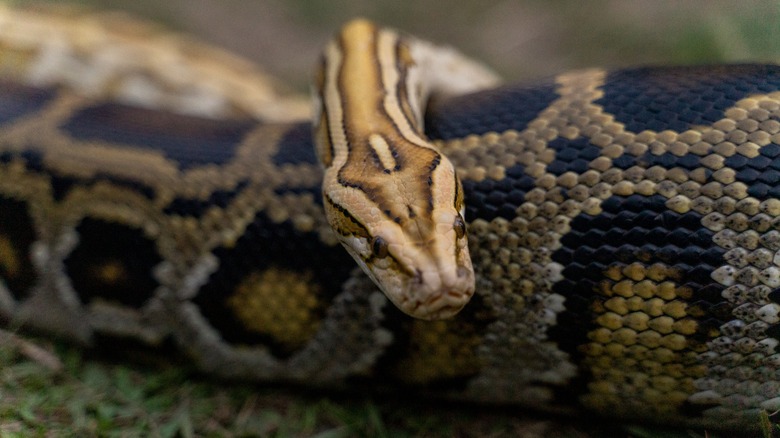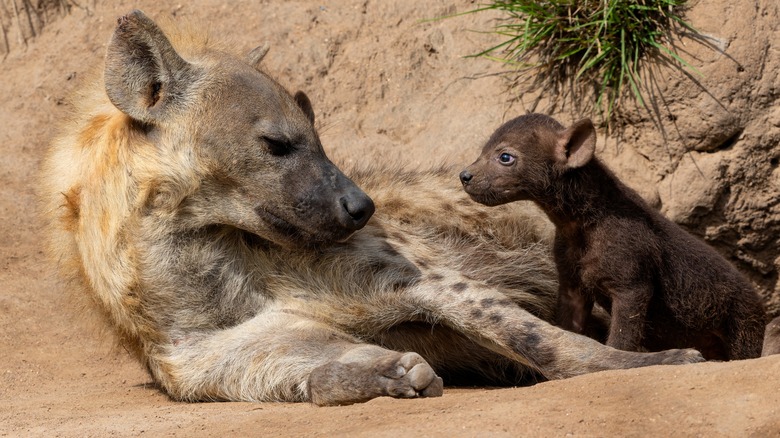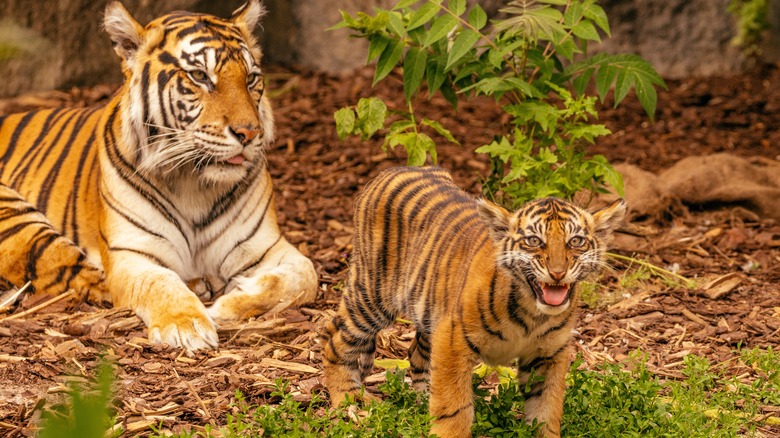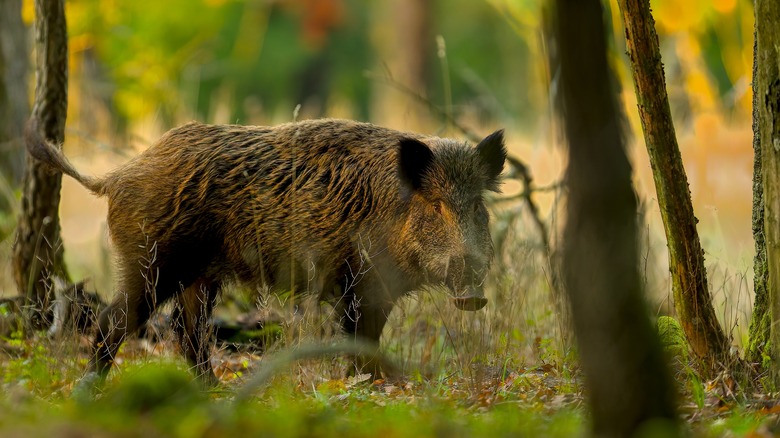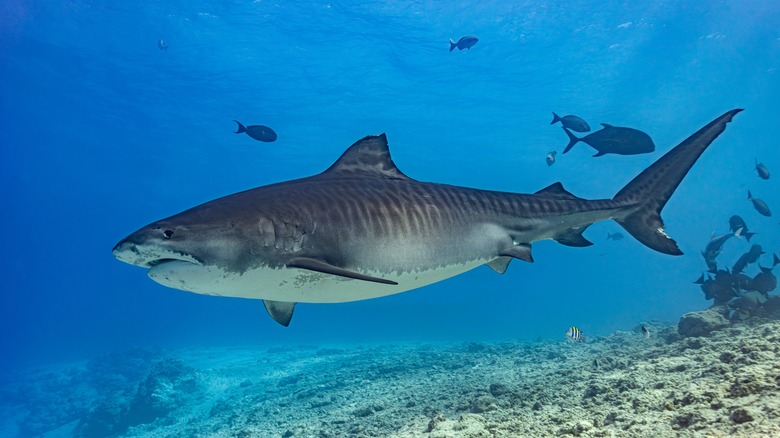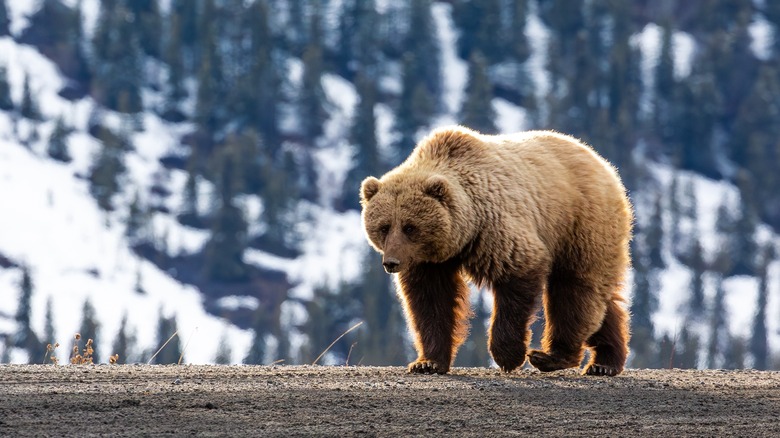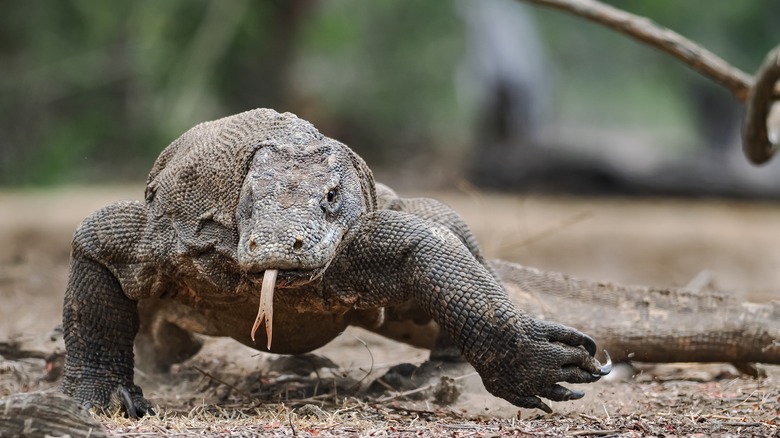9 Animals That See Humans As Food
Of the many stresses and worries of everyday modern life, the one thing we generally don't need to be concerned about is being eaten. At the top of the food chain, it has been millennia since we took on dire wolves and saber-toothed tigers before they went extinct, but there are still a few animals out there that require a bit of caution.
While the animal that causes the most deaths by quite some margin is the tiny mosquito, there are still some animals across the globe that kill and eat humans from time to time, and even a handful that actively hunt us. From the terrifying saltwater crocodile to the surprisingly dangerous wild boar, fatal human attacks may be rare, but they do happen. In most cases, attacks are the result of an animal feeling threatened and defending its habitat or young, so keeping out of their territory is the safest way to prevent disaster. Let's take a look at nine animals who see humans as food.
Saltwater crocodile
As the largest reptile currently walking (and swimming) the planet, the saltwater crocodile is a beast to be reckoned with. They are primarily found in Asia and Oceania, and they are masters of the ambush attack. They have a varied diet that includes birds, fish, and mammals, and if a human happens to get too close, they may find themselves on the menu, too.
Crocodiles in general kill around 1,000 humans a year, and the saltwater crocodile is the largest attacker, and therefore among the most terrifying. At their biggest, males can be up to 23 feet in length and weigh more than 1,000 pounds. Crocs are known for waiting silently and motionless in the water, and pouncing when prey ventures to the water's edge. If that prey happens to be a human, the saltwater crocodile is not fussy, and with the strongest bite force in the animal kingdom at a petrifying 3,700 pounds per square inch, no animal stands a chance once the saltwater croc has decided on its dinner.
The good news is, there is a way to escape if you spot the crocodile quick enough — run! As long as you are on land, most people could outrun any crocodile, since their peak speed is just below 9 miles per hour whereas the average human can sprint at about 14 miles per hour . If you are in the water, however, you are at a huge disadvantage, so get yourself onto dry land as soon as you possibly can.
Lions
As the king of the jungle, the lion is portrayed as one of the most fearsome animals on the planet, and the fact that they kill around 250 humans a year means we have every reason to be wary of them. With their enormous size and impressive bite force, keeping a safe distance from a lion is usually a good idea.
Adult male lions can weigh close to 600 pounds and grow to over 8 feet long, allowing them to bring down large animals for food. Although they don't actively hunt humans, if we were to stray into their territory and disturb the pack, they could launch a potentially fatal attack. If you have seen an agile zebra or springbok outrun a lion on a nature show and assumed that you could do the same, you'd better have a plan B instead. Lions can sprint at speeds up to 37 miles per hour, so at our measly 14 miles per hour average is simply not going to cut it. And with a bite force of 1,000 psi, you do not want to find yourself on the wrong end of those teeth.
Thankfully, lion attacks on humans are rare, especially if on a guided tour such as a safari. The majority of attacks are on locals who encroach on their territory, so as long as you stay in the safety of a safari vehicle, you are likely to be safe.
Reticulated pythons
Ophidiophobia is the name for an extreme fear of snakes, and it is one of the most common phobias, even though the majority of snakes are harmless to humans. There are a few, however, that justify the terror associated with them, one of which is the reticulated python.
This particular snake has been known to grow to over 30 feet long, and they are happy to hunt and kill primates, which, rather unfortunately, includes humans. Though rare, there have been reports of these pythons swallowing humans whole, and as a constrictor, they can kill them very quickly. Often biting them first, they then wrap their formidable coils around their prey, then take advantage of each breath to squeeze tighter. Once dead, the snake dislocates its jaw to accommodate the enormity of its prey and swallows it whole over the course of an hour.
Thankfully, fatal attacks are very rare, meaning that an Indiana Jones level of snake fear is unjustified for most. However, given the right opportunity, these enormous pythons are more than capable of having a human for lunch.
Hyenas
Hyenas tend to get a bad rap compared to the rest of the animal community, perhaps due to their portrayal as villains in a particular animated movie. In real life, they are actually fantastic hunters and can take down enormous prey, including, in rare cases, humans.
They can run as fast as 37 miles per hour, and what's more, they are able to sustain this for long stretches in order to chase down their prey. Spotted hyenas, which can grow to just under 6 feet in length and nearly 3 feet in height, can bring down zebra, buffalo, and even small rhinos. They work in packs, allowing them to successfully hunt animals much larger than you might expect they can.
Hyenas can be found in Africa and Asia, and though human attacks are rare, a man was tragically killed in 2024 by a small pack of hyenas near Nairobi National Park, which is a reminder that when their habitat is encroached upon, these natural predators can attack and cause serious harm. The Kenyan Wildlife Service told Sky News, "If faced with a hyena, do not move away until it does, and continue facing its direction. Be loud, look aggressive, and appear frightening to deter the hyena."
Tigers
When it comes to fearsome animals that would strike terror into the hearts of most of us if we came across them, tigers are pretty high up the list. Even bigger than lions, they are the largest of the big cats, and they're responsible for up to 100 human deaths every year.
The largest tigers are the Siberian tigers living in Northern Asia, and on average they weigh almost 700 pounds and can grow up to 10.5 feet in length. Unlike their lion cousin, who hunt in packs, tigers are usually solitary hunters, and on top of that, they're masters of stealth and camouflage. Since tigers usually attack from behind, if you are unlucky enough to find yourself in the path of a hungry one, you will have little warning. Even if you saw it coming, though, the 40 miles per hour that a tiger can potentially sprint at means that you would have no chance anyway.
Thankfully, true man-eating tigers and attacks on humans are rare. However, with humans expanding into their territory, and unfortunately, the efforts to protect this endangered animal means that human encounters with them are likely to increase.
Wild pigs
Pigs may not be the first animal that springs to mind when thinking of ferocious, man-eating creatures, but wild pigs are more aggressive than you may have ever thought. In rural areas in particular, wild pigs and boars have been known to attack humans, and on rare occasions, these encounters can be fatal. In fact, in recent years, there have been more deaths resulting from pig attacks than from shark attacks.
Male wild boars can grow up to 6 feet in length and weigh as much as 300 pounds, though the heaviest ever boar was 800 pounds. If a wild boar attacks a human with its tusks, the damage can be catastrophic, and 55% of recorded fatalities died at the scene. The proximity of a boar's head to important arteries in the human body mean that a stab with their incredibly sharp tusks can be a fatal wound.
Wild pig attacks are much more common in rural areas, meaning the chances of coming across one in the suburbs are not high. However, those who live near forests or agricultural land should take care, especially around a group of males, as they can easily afflict fatal injuries in a very short space of time.
Sharks
As man-eating predators go, sharks are near the top in the minds of most people. Thanks to the famous 1975 movie, many people have an extreme fear of sharks, and so they might assume that they kill humans for fun. However, while some sharks are more likely to kill humans than others, they are actually to blame for fewer annual fatalities than crocodiles, elephants, and even bees.
In the shark world, it is the classic case of a few aggressive species spoiling the reputations of the rest of the well-behaved guys. Tiger sharks, bull sharks, and, of course, the famous great white sharks (which risk takers might want to find in Massachusetts) are responsible for the vast majority of all human shark-related deaths. Great whites, who can reach up to 20 feet in length, have the most human deaths to their name, with 59 official fatalities — but this is the total number ever recorded, not those counted in one single year. Tiger sharks and bull sharks are the next most dangerous, with 39 and 26 deaths respectively. Beyond this however, there have been only a handful of human deaths ever recorded from other shark species.
If you are ever in the rare but unfortunate situation of being attacked by a shark, you should strike it on the nose, eyes, or gills, as these are the most sensitive areas of the shark. Then get out of the water. Quickly!
Bears
Many of us are naturally afraid of bears, and although they rarely go after humans intentionally, their enormous size and great power make them a formidable opponent if you happen to run into them on a bad day. The average number of black bear deaths in the U.S. per year is only 1, but it does show that bears will attack if they feel threatened.
Though the largest bear species today might be nothing compared to its prehistoric ancestors, polar bears are the largest bears you'll find today, and they're rather intimidating, at that. Therefore, they're perhaps the most likely to attack a human in theory, but their remote habitat means that they come in contact with relatively few humans. However, their sheer brute force and the fact that food is scarce means that a human is highly unlikely to survive an attack from a polar bear if it were to occur, and they can attack humans, either out of defense or hunger.
Grizzly bears are responsible for the most human deaths, however, due to their weight of up to 900 pounds, and immense bite force of 1,000 psi. In most cases, however, these deaths can be prevented by avoiding all contact with the bears, who are most likely to attack if they think their young are threatened. If you are attacked by a bear, playing dead is your best strategy, and hopefully it will retreat and allow you to escape unharmed.
Komodo dragons
The Komodo dragon may sound like something from a fantasy novel, but they are very real, and they can be dangerous, too. These enormous lizards are the largest on Earth, and they've been known to both attack and kill humans.
They can reach up to 10 feet long and weigh more than 300 pounds, and their usual diet consists of mammals, including deer and water buffalo. They are also cannibals, and can eat younger Komodo dragons, though they need to catch them first. As a rule, they don't tend to hunt humans, but there have been a few documented cases of attacks, particularly in recent years. In 2007, an 8-year-old boy was attacked and killed by a Komodo dragon, and two years later, a fruit picker was mauled to death after falling out of a tree. These attacks show that the Komodo dragon can cause serious injury to humans, despite the fact that attacks are still rare. Of course, their physical attributes includes sharp teeth and claws in addition to their intimidating size, which makes them an animal we wouldn't be looking to mess with anyway.
